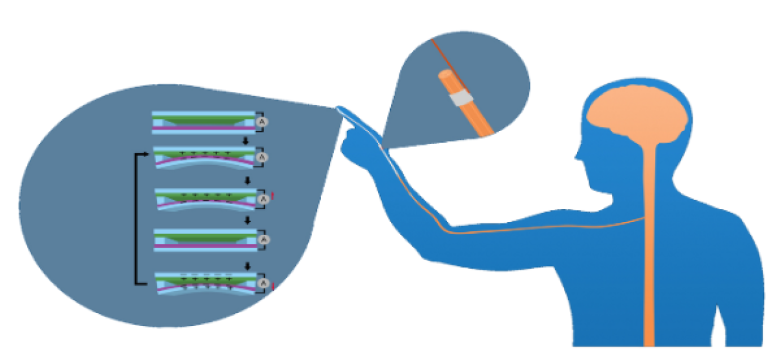How it works
We developed a tactile sensor that is based on a Tribo-Electric Nano-Generator (TENG).
It converts mechanical energy into an electric charge using the triboelectric effect.
Similar to the way rubbing a balloon against one’s head creates static charge, applying pressure causes the TENG’s layers to touch and creates electricity.

What makes us different
The Ts-TENG will be implanted under the skin of the desensitized finger.
Applying pressure on the Ts-TENG will generate an electrical signal.

The electrical signal will be delivered using isolated cables to a stimulating cuff electrode wrapped around the closet undamaged afferent nerve fiber.
A touch sensation signal can be delivered to the CNS.





Loss of tactile sensation derives from several reasons
Traumatic Injuries
Neuropathic Diseases Diabetes
Mastectomy
And is a problem for tens of millions worldwide
Loss of tactile sensation is a common phenomenon in patients with traumatic peripheral nerve injury (PNI) or a chronic disease.
The loss of sensation involves a significant functioned limitation and the risk of injuries.
The conventional surgical procedures are time restricted and success rates are limited.
Inability to perform daily activity
Risk of secondary injuries
Loss of work capacity
Decreased mental health
Increased healthcare costs
Get in touch
© 2023 Tengable. All rights reserved.
We developed a tactile sensor that is based on a Tribo-Electric Nano-Generator (TENG).
It converts mechanical energy into an electric charge using the triboelectric effect.
Similar to the way rubbing a balloon against one’s head creates static charge, applying pressure causes the TENG’s layers to touch and creates electricity.

What makes us different
The Ts-TENG will be implanted under the skin of the desensitized finger.
The electrical signal will be delivered using isolated cables to a stimulating cuff electrode wrapped around the closet undamaged afferent nerve fiber.

Applying pressure on the Ts-TENG will generate an electrical signal.
A touch sensation signal can be delivered to the CNS.





Loss of tactile sensation derives from several reasons
Traumatic Injuries
Neuropathic Diseases Diabetes
Mastectomy
And is a problem for tens of millions worldwide
Loss of tactile sensation is a common phenomenon in patients with traumatic peripheral nerve injury (PNI) or a chronic disease.
The loss of sensation involves a significant functioned limitation and the risk of injuries.
The conventional surgical procedures are time restricted and success rates are limited.
Inability to perform daily activity
Risk of secondary injuries
Loss of work capacity
Decreased mental health
Increased healthcare costs
Get in touch
© 2023 Tengable. All rights reserved.
